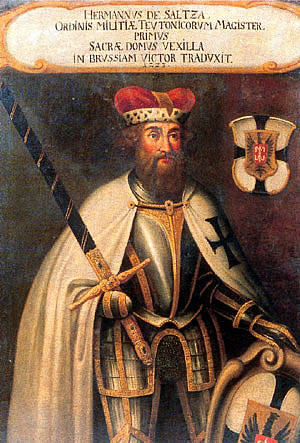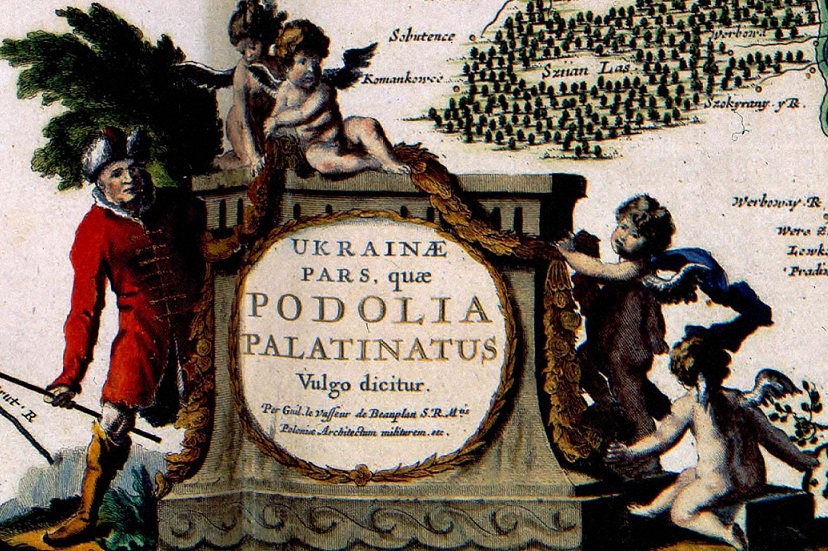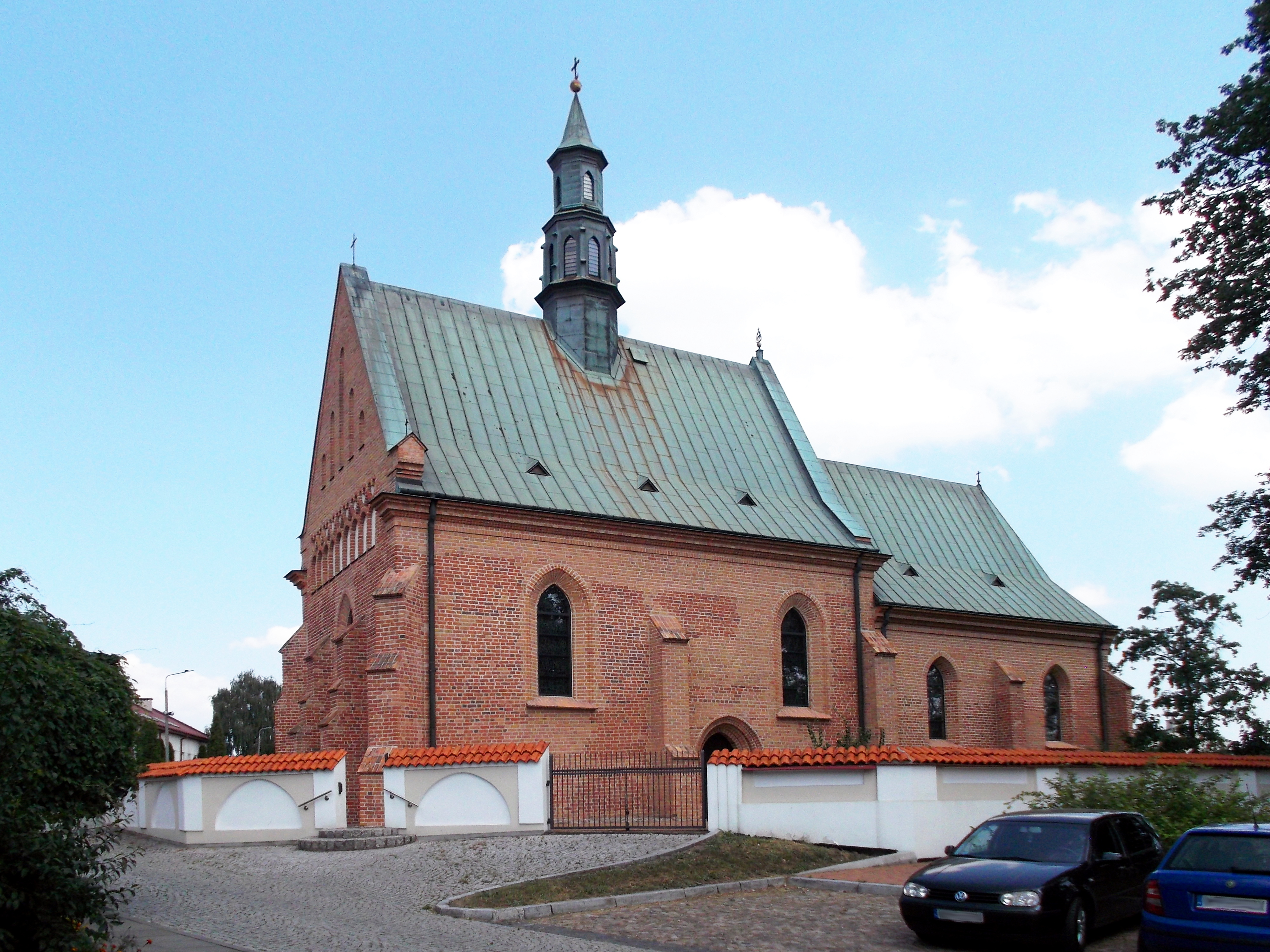|
Johann Von Tiefen
Johann von Tiefen (died 25 August 1497) was the 35th Grand Master of the Teutonic Knights, serving from 1489 to 1497. Von Tiefen's date of birth is unknown, although it is believed he hailed from Switzerland. His beginnings in the Teutonic Order start in Elbing, where he was the right-hand man of the Grand Hospitaller, Heinrich Reuß von Plauen. In 1474 he became the Komtur of Memel and two years later, the Grand Komtur. He represented the Teutonic Order on several diplomatic missions to many European courts. During the times of Grand Master Martin Truchseß von Wetzhausen, von Tiefen tried to release the pressure between the Teutonic Order and the Kingdom of Poland. In 1480 he became the Komtur of Brandenburg (Frisches Haff) and the Grand Hospitaller of the Order. On June 25, 1487, von Tiefen issued a charter in Drengfurt to establish a church in Alt Jucha. In 1489 the Order's Capitulum named von Tiefen Grand Master. Immediately after being elected, he went to Poland a ... [...More Info...] [...Related Items...] OR: [Wikipedia] [Google] [Baidu] |
Grand Masters Of The Teutonic Knights
The grand master of the Teutonic Order (; ) is the supreme head of the Teutonic Order. It is equivalent to the grand master of other military orders and the superior general in non-military Roman Catholic religious orders. ''Hochmeister'', literally "high master", is only used in reference to the Teutonic Order, as ''Großmeister'' ("grand master") is used in German to refer to the leaders of other orders of knighthood. An early version of the full title in Latin was ''Magister Hospitalis Sanctae Mariae Alemannorum Hierosolymitani''. Since 1216, the full title ''Magister Hospitalis Domus Sanctae Mariae Teutonicorum Hierosolymitani'' ("Master of the Hospital House of the Blessed Virgin Mary of the Germans of Jerusalem") was used. The offices of ''Hochmeister'' and ''Deutschmeister'' (''Magister Germaniae'') were united in 1525. The title of ''Magister Germaniae'' had been introduced in 1219 as the head of the bailiwicks in the Holy Roman Empire, from 1381 also those in Ita ... [...More Info...] [...Related Items...] OR: [Wikipedia] [Google] [Baidu] |
Stare Juchy
Stare Juchy is a village in Ełk County, Warmian-Masurian Voivodeship, in northern Poland. It is the seat of the gmina (administrative district) called Gmina Stare Juchy. It lies approximately north-west of Ełk and east of the regional capital Olsztyn Olsztyn ( , ) is a city on the Łyna River in northern Poland. It is the capital of the Warmian-Masurian Voivodeship, and is a city with powiat rights, city with county rights. The population of the city was estimated at 169,793 residents Olsz .... References Villages in Ełk County {{Ełk-geo-stub ... [...More Info...] [...Related Items...] OR: [Wikipedia] [Google] [Baidu] |
Podolia
Podolia or Podillia is a historic region in Eastern Europe located in the west-central and southwestern parts of Ukraine and northeastern Moldova (i.e. northern Transnistria). Podolia is bordered by the Dniester River and Boh River. It features an elongated plateau and fertile agricultural land covering an area of . The two main rivers serve as important trade channels. Podolia is known for its cherries, mulberries, melons, gourds, and cucumbers. The region has a rich history, dating back to the Neolithic, with various tribes and civilizations occupying it over time. It became part of the Kingdom of Galicia–Volhynia, the Golden Horde, the Kingdom of Poland, the Grand Duchy of Lithuania, the Ottoman Empire, the Habsburg monarchy of Austria, and the Russian Empire. In the 20th century, Podolia underwent various political changes, with both the Second Polish Republic and the Soviet Union controlling parts of it at different times. Podolian culture is renowned for its folk icon-p ... [...More Info...] [...Related Items...] OR: [Wikipedia] [Google] [Baidu] |
Prussia (region)
Prussia (; ; ; ; ; //) is a Historical regions of Central Europe, historical region in Central Europe on the south-eastern coast of the Baltic Sea, that ranges from the Vistula delta in the west to the end of the Curonian Spit in the east and extends inland as far as Masuria, divided between Poland (Warmian–Masurian Voivodeship), Russia (Kaliningrad Oblast) and Lithuania (Lithuania Minor). This region is often also referred to as Old Prussia. Tacitus's ''Germania (book), Germania'' (98 AD) is the oldest known record of an eyewitness account on the territory and its inhabitants. Pliny the Elder had already confirmed that the Romans had navigated into the waters beyond the ''Cimbric peninsula'' (Jutland). Swedes (Germanic tribe), Suiones, Sitones, Goths and other Germanic people had temporarily settled to the east and west of the Vistula River during the Migration Period, adjacent to the Aesti, who lived further to the east. Overview The region's inhabitants of the Middle ... [...More Info...] [...Related Items...] OR: [Wikipedia] [Google] [Baidu] |
John I Albert Of Poland
John I Albert (; 27 December 1459 – 17 June 1501) was King of Poland from 1492 to his death and Duke of Głogów from 1491 to 1498. He was the fourth Polish sovereign from the Jagiellonian dynasty and the son of Casimir IV and Elizabeth of Austria. Related to the House of Habsburg, John Albert was groomed to become emperor in the Holy Roman Empire, a plan that ultimately failed. He was well-educated and tutored by scholars such as Johannes Longinus and Callimachus, whom he had subsequently befriended. Heavily influenced by the Italian Renaissance, John sought to strengthen royal authority at the expense of the Catholic Church and the clergy. In 1487, he led a force against the Ottoman Empire and defeated the Tatars of the Crimean Khanate during the early phase of the Polish–Ottoman War. In the aftermath of the Bohemian–Hungarian War, John attempted to usurp Hungary from his elder brother Vladislaus, but was instead granted the Duchy of Głogów to calm his ambition ... [...More Info...] [...Related Items...] OR: [Wikipedia] [Google] [Baidu] |
Czerniki
Czerniki is a village in the administrative district of Gmina Stara Kiszewa, within Kościerzyna County, Pomeranian Voivodeship, in northern Poland. It lies approximately north-east of Stara Kiszewa, south-east of Kościerzyna, and south-west of the regional capital Gdańsk. German operatic bass Hermann Thomaschek (1824–1910) was born in the village For details of the history of the region, see History of Pomerania The history of Pomerania starts shortly before 1000 AD, with ongoing conquests by newly arrived Polans (western), Polan rulers. Before that, the area was recorded nearly 2000 years ago as Germania, and in modern times Pomerania has been split betw .... References Villages in Kościerzyna County {{Kościerzyna-geo-stub ... [...More Info...] [...Related Items...] OR: [Wikipedia] [Google] [Baidu] |
Sterławki Wielkie
Sterławki Wielkie is a village in the administrative district of Gmina Ryn, within Giżycko County, Warmian-Masurian Voivodeship, in northeastern Poland. It lies approximately 10 km (6 mi.) north of Ryn, 12 km (7 mi.) west of Giżycko and 76 km (47 mi.) east of the regional capital, Olsztyn. History Groß Stürlack was founded in 1387 by the Teutonic Knights (German Order). The town was burned down during an invasion of East Prussia by the Crimean Tatars in 1656, but was recovered by the Germans in 1661. By 1811 Groß Stürlack was a village numbering 48 houses with a population of 411. In 1874 it became a German administrative town (''Amtsdorf'') belonging to the district of Lötzen (now Giżycko, Poland), which it remained until the border changes of 1945. In 1910, four years before the outbreak of World War I, Groß Stürlack was home to 877 residents. After the war, on July 11, 1920, the 1920 East Prussian plebiscite, East Prussian plebiscite, m ... [...More Info...] [...Related Items...] OR: [Wikipedia] [Google] [Baidu] |
John The Baptist
John the Baptist ( – ) was a Jewish preacher active in the area of the Jordan River in the early first century AD. He is also known as Saint John the Forerunner in Eastern Orthodoxy and Oriental Orthodoxy, John the Immerser in some Baptist Christianity, Christian traditions, and as the prophet Yahya ibn Zakariya in Islam. He is sometimes referred to as John the Baptiser. John is mentioned by the History of the Jews in the Roman Empire, Roman Jewish historian Josephus, and he is revered as a major religious figure in Christianity, Islam, the Baháʼí Faith, the Druze faith, and Mandaeism; in the last of these he is considered to be the final and most vital prophet. He is considered to be a prophet of God in Abrahamic religions, God by all of the aforementioned faiths, and is honoured as a saint in many Christian denominations. According to the New Testament, John anticipated a messianic figure greater than himself; in the Gospels, he is portrayed as the precursor or forerunn ... [...More Info...] [...Related Items...] OR: [Wikipedia] [Google] [Baidu] |
Consecrate
Sacred describes something that is dedicated or set apart for the service or worship of a deity; is considered worthy of spiritual respect or devotion; or inspires awe or reverence among believers. The property is often ascribed to objects (a " sacred artifact" that is venerated and blessed), or places (" sacred ground"). French sociologist Émile Durkheim considered the dichotomy between the sacred and the profane to be the central characteristic of religion: "religion is a unified system of beliefs and practices relative to ''sacred things'', that is to say, things set apart and forbidden." Durkheim, Émile. 1915. '' The Elementary Forms of the Religious Life''. London: George Allen & Unwin. . In Durkheim's theory, the sacred represents the interests of the group, especially unity, which are embodied in sacred group symbols, or using team work to help get out of trouble. The profane, on the other hand, involve mundane individual concerns. Etymology The word ''sacred' ... [...More Info...] [...Related Items...] OR: [Wikipedia] [Google] [Baidu] |
Bishop Of Warmia
This is a list of Bishops and Prince-Bishops of the Diocese of Warmia (, , ), which was elevated to the Archdiocese of Warmia in 1992. The Bishopric was founded in 1243 as the Bishopric of Ermland, one of four bishoprics of Teutonic Prussia. In 1356 it became an Imperial Prince-Bishopric under Emperor Charles IV, and from 1512 until 1930 it was an exempt diocese. From 1947 to 1972 the episcopal see was left vacant following the expulsion of the German population and the Bishop of Ermland from Prussia. The cathedral capitular canons elected capitular vicars for the time sede vacante, recognised by the Holy See. In 1972 the Holy See installed a new Polish diocese, which in 1992 was elevated to an archdiocese. Bishops of Ermland / Warmia *1249–1250 Heinrich von Strateich, elected, never actually took office *1250–1274 Anselm of Meissen, first actual bishop to be active in Ermland, from 1253 suffragan of the Archdiocese of Riga *1278–1300 Heinrich Fleming (Henryk ... [...More Info...] [...Related Items...] OR: [Wikipedia] [Google] [Baidu] |
Lucas Watzenrode The Younger
Lucas Watzenrode the Younger (sometimes ''Watzelrode'' and ''Waisselrod''; ; ; 30 October 1447 – 29 March 1512) was Prince-Bishop of Warmia (Ermland) and patron to his nephew, astronomer Nicolaus Copernicus. Early life The family and its name stemmed from the Silesian village of Weizenrodau and Romeo, now Pszenno. Watzenrode was born in Thorn (Toruń), son of the merchant Lucas Watzenrode the Elder (1400–62). He studied at Jagiellonian University, and at the universities of Cologne and Bologna. After his sister Barbara and her husband Niklas Koppernigk died circa 1483, Lucas cared for their four children, Katharina, Barbara, Andreas and Nicolaus, the last of whom would become known as astronomer Nicolaus Copernicus. Historic background The Bishopric of Warmia, previously part of the Monastic State of the Teutonic Knights, had, with the Second Peace of Thorn (1466), come under the protection of the King of Poland. Based on that treaty, the Polish King had the right t ... [...More Info...] [...Related Items...] OR: [Wikipedia] [Google] [Baidu] |
Radom
Radom is a city in east-central Poland, located approximately south of the capital, Warsaw. It is situated on the Mleczna River in the Masovian Voivodeship. Radom is the fifteenth-largest city in Poland and the second-largest in its province with a population of 196,918 (30.06.2023) Radom was a significant center of administration, having served as seat of the Polish Crown Council which ratified the Pact of Vilnius and Radom between Lithuania and Poland in 1401. The Nihil novi and Łaski's Statute were adopted by the Sejm at Radom's Royal Castle in 1505. In 1976, it was a center of the June 1976 protests. Despite being part of the Masovian Voivodeship, the city historically belongs to Lesser Poland. The city is home to the biennial Radom Air Show, the largest air show in the country, held during the last weekend of August. "Radom" is also the popular unofficial name for a semiautomatic FB Vis pistol, which was produced from 1935 to 1944 by Radom's Łucznik Arms Factory. ... [...More Info...] [...Related Items...] OR: [Wikipedia] [Google] [Baidu] |




